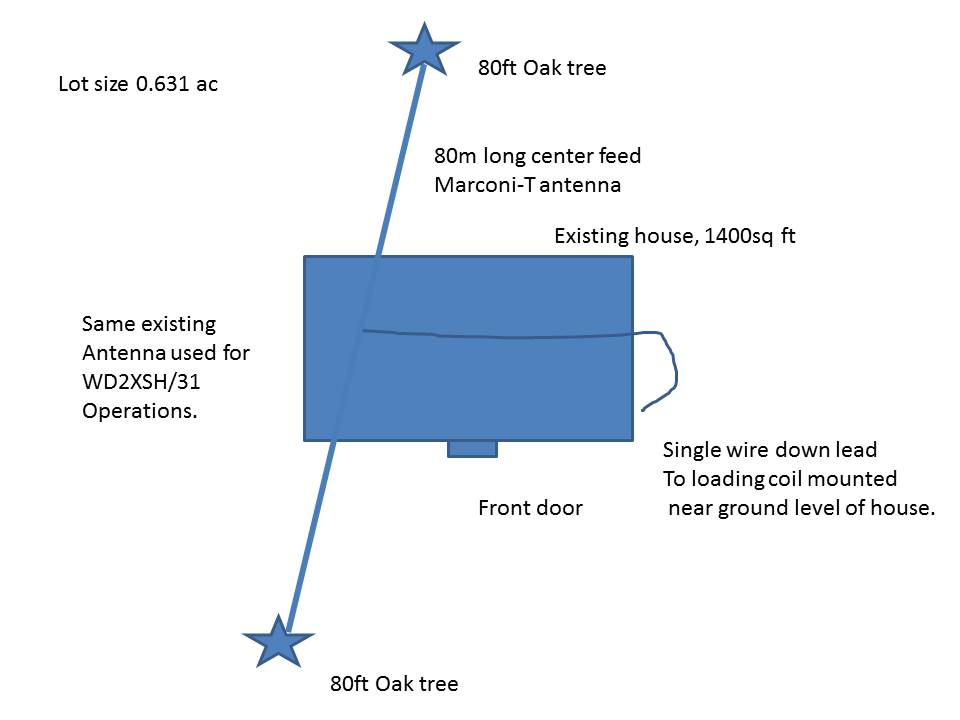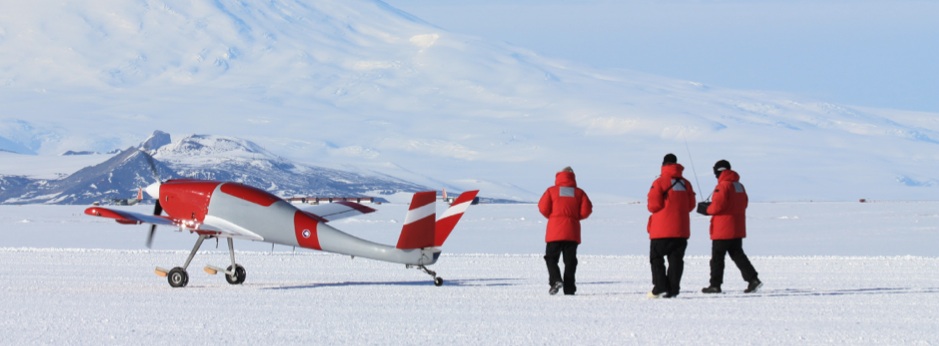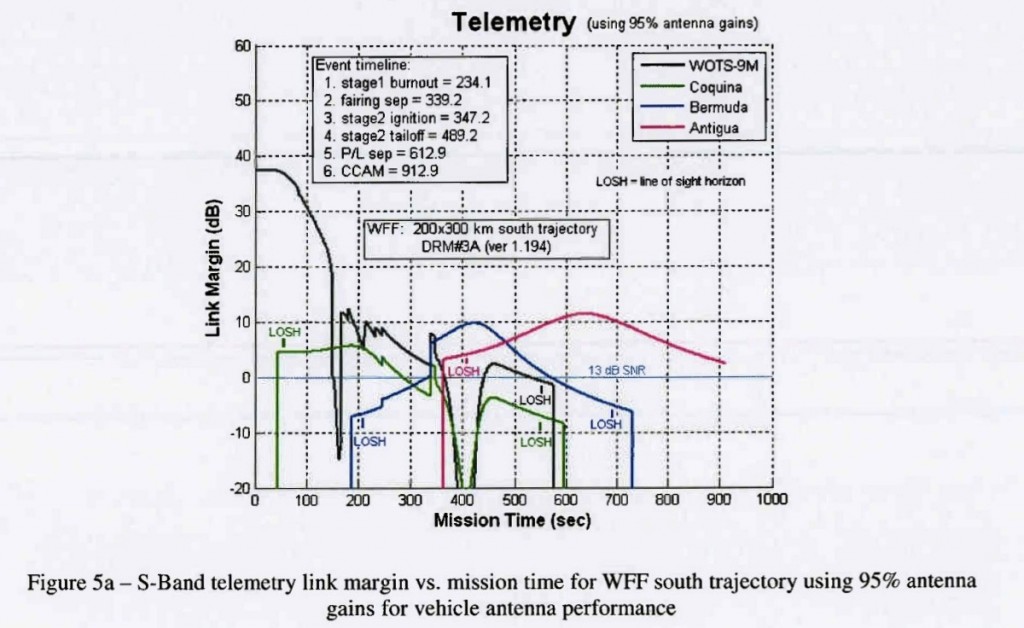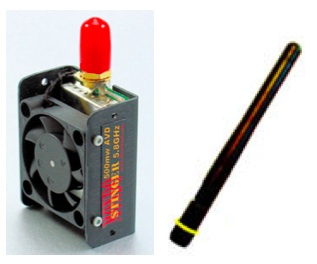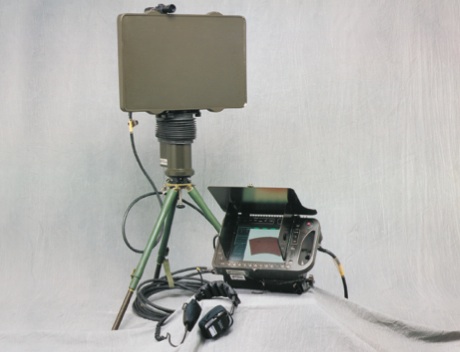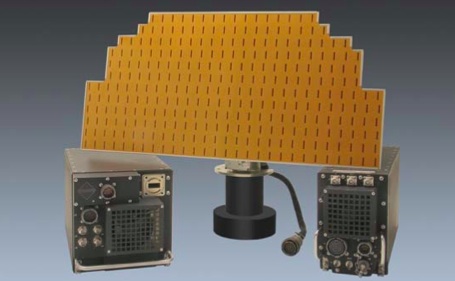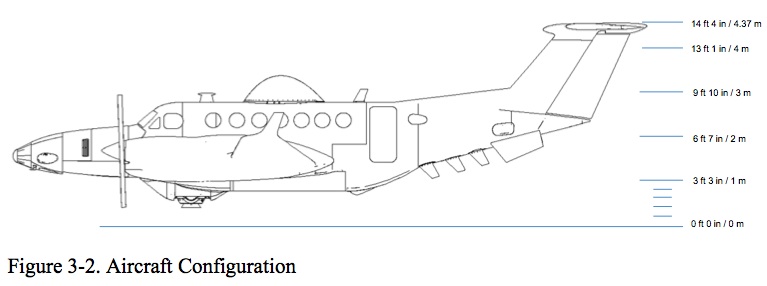Experimental Radio Applications at the FCC
This summarizes a selection from 215 applications for the Experimental Radio Service received by the FCC during October, November, and December 2011. These are related to AM broadcasting, FM broadcasting, spread spectrum on HF and VHF, unmanned aerial vehicle control, electronic warfare support, small satellites, white space technology, video production, managed access, TV interference, RFID, and radar. The descriptions are listed in order of the lowest frequency found in the application.

- Amateur Radio operator Brian Justin filed an application with exhibit (shown below) for special temporary authority to “be able to operate antique Heising modulation on 470.0 kHz on or about x-mas evening and several other days” to commemorate Reginald Fessenden’s “original claimed voice transmissions over 100 yrs ago.” The transmissions were to take place on 470-475 kHz from Forest, Virginia.
- Chesapeake Operating, Inc. filed an application with exhibit for special temporary authority to “provide music and announcements throughout Chesapeake’s corporate campus” and for “determining propagation and coverage while simultaneously considering a waiver to operate permanently under 15.221(b)” of the FCC’s Rules. Operation is to be on 1300 kHz and 1610 kHz in Oklahoma City, Oklahoma. The applicant says it’s parent company, Chesapeake Energy, “is the Nation’s second-largest producer of natural gas, a top 15 producer of oil and natural gas liquids and the most active driller of new wells in the U.S.” “Chesapeake is considering the use of low power AM broadcasts at its corporate campus that could be used for a variety of purposes. For example, the system could be used for disseminating severe weather information (e.g., tornado watches, tornado warnings, ice storms, etc.,) street closings, traffic re-routes due to construction, as well as during outdoor events such as the farmers market that Chesapeake sponsors during the summer months and outdoor activities associated with United Way campaigns, concerts, and family events.”
- Phillip J. Williams filed an application with exhibits for special temporary authority to operate using spread spectrum on HF and VHF frequencies in the Amateur Radio Service. Current rules don’t permit spread spectrum operation below 220 MHz. In the tests, comparisons will be made with other digital modes such as JT65A, Olivia, MT63 and PSK31, including with regard to weak-signal capabilities. Experiments will focus on minimum required transmitter power and developing operating procedures for the Amateur Radio community. Operation will take place in Euless, Texas in various Amateur bands between 1.8 and 148 MHz.
- The Center for Remote Sensing of Ice Sheets at the University of Kansas filed an application with exhibits for experimental license to conduct testing of a 72 MHz link used to control the “Meridian Uninhabited Aircraft System,” an aircraft that carries a variety of scientific payloads, including ice-penetrating radar, for research on the flow-ice sheets in Greenland and Antarctica. Operation will be at several locations in Kansas and Utah on 72.01-72.99 MHz.
- National Public Radio filed an application with exhibits for experimental license to evaluate the feasibility of using a Cognitive Modulator. This is envisioned as an alternative to consumer FM modulators long used to allow audio from a personal electronic device to be played through a vehicle’s FM radio. These modulators have their drawbacks: they can cause interference to other FM listeners, FCC rules limit their power such that it can be difficult for them to overcome interference, and they may need to be retuned as the vehicle travels into range of new, interfering FM stations. Preliminary testing led by NPR suggests a Cognitive Modulator operating at 87.7 MHz may present a solution to the above service problems. Such a device would sense the amount of interference and noise (I+N) at or around 87.7 MHz and adjust its transmitter carrier power to provide a desired C/(I+N) in a vehicle’s FM radio. Experimental operation will be in New Haven, Connecticut on 87.7 MHz
- Lockheed Martin filed an application with exhibits for experimental license to operate at Syracuse, New York on various frequencies in the bands 109.375-137.000, and 960-1400 MHz. This is to test electronic-support-measures receiver systems for the U.S. Navy on vessels being deployed overseas.
- Cosmogia Inc. filed an application with exhibits for special temporary authority to operate communications inks in support of the Dove 1 satellite mission. This is a “technology demonstration to: a) test the basic capabilities of the low-cost bus built from non-space, Commercial Off-the-Shelf (COTS) components; b) show that a bus constrained to the 3U cubesat form factor can host a small payload; and c) demonstrate the ability to design, produce and operate satellites on short schedules and low cost. Dove 1 will do this by transmitting health and payload data to the ground.” The satellite is due to be launched as a secondary payload on the maiden flight of the Taurus II from NASA’s Wallops Flight Facility. It will be placed in a nearly circular orbit of 280 km, which will decay with the satellite burning up in the Earth’s atmosphere approximately 2 weeks after launch. Amateur beacon transmissions on 145.825 MHz will commence upon deployment of the satellite. A half-duplex, spread-spectrum radio on 2.4016-2.4776 GHz will be used for main payload downlink and for telecommand uplink. The satellite has dimensions of 10 cm x 10 cm x 30 cm. Its mass is about 5 kg.
- The Wisconsin Wireless and NetworkinG Systems (WiNGS) Laboratory at the University of Wisconsin, Madison, filed an application with exhibit for experimental license to test fixed point-to-point backhaul and vehicular networking on TV white=space frequencies. Operation will be in the vicinity of Madison, Wisconsin on 174-216, 470-608, and 614-698 MHz. The experimental platform is called Wide Band Digital Radio. Its major function is to perform frequency translation from Wi-Fi frequencies in the 2.4 GHz range to UHF-TV frequencies.
- Lockheed Martin filed an application with exhibits for experimental license to conduct radiosonde factory acceptance testing as part of a government contract. During testing, the radiosondes are attached to a weather balloon and deployed from a Lockheed Martin facility in Marion, Massachusetts. The weather balloon can travel a ground distance of 250 km and reach a height of 30 km. The average duration of the deployment is 135 minutes. The expected number of deployments is about five per month. The radiosonde transmitter uses a monopole antenna that directs transmitted power towards the ground. Testing will take place on various frequencies between 400.25 and 405.5 MHz.
- Carlson Wireless filed an application with exhibit for special temporary authority to test white-space radio technology in rural locations of Hawaii prior to database and device certification. This is to compare performance of white-space radio propagation to that of WiMAX and 900 MHz radios in very dense tropical cover and in heavy rain conditions. Operation will be in Pahoa, Hawaii and in Keaau, Hawaii on 470-608 and 614-698 MHz.
- America’s Cup Event Authority, LLC filed an application with exhibit for special temporary authority to permit video production, and to coordinate operations and security for the Americas Cup World Series Sailboat Race in the vicinity of San Diego. Several frequency bands are requested including 470-476, 476-482, 482-488, and 506-512 MHz (i.e., television broadcast channels 14, 15, 16 and 20), television broadcast auxiliary frequencies 2025-2110 MHz, and amateur frequencies at 2390-2400 MHz and 3300-3500 MHz.
- Robert Miller Consulting filed an application with exhibits for special temporary authority to operate on TV channel 44, 650-656 MHz, near Green Bay, Wisconsin to conduct research on the effects of wind turbines on over-the-air TV reception. The applicant says the “proliferation of wind turbine deployment and the associated history of television interference problems have prompted an urgent need for development of tools to assist in the placement of the turbines so as to minimize interference.” This testing is funded by the U.S. Department of Agriculture, and there is the prospect of more funding for more exhaustive tests depending on these initial test results.
- ShawnTech Communications filed an application with exhibits for special temporary authority to operate in Ridgeville, South Carolina on 851-869, 869.2-893.8, 869.70-893.31, 1930.2-1989.8, and 1931.25-1988.75 MHz. Details are not available due to a request for confidentiality. This appears to be a test of a managed-access cellular system for intercepting unauthorized phone calls from a prison. It further appears that a cellular operator gave its consent for the test.
- Boeing filed an application with exhibits for special temporary authority to test RFID tags that Boeing and commercial airlines use on various items aboard commercial aircraft. The device being used is certified for unlicensed use in Europe but not in the U.S. Testing will be in Goodyear, Arizona on 865-867 MHz.
- The South Coast Air Quality Management District filed an application with exhibits for experimental license to operate a wind-profiling radar, which depends on the scattering of transmitted signals by irregularities in the index of refraction of the atmosphere. The irregularities are caused by turbulence in the wind. By determining the Doppler frequency shift, the speed of the wind can be determined. Temperature data can be obtained by measuring the propagation velocity of an acoustic signal. The hardware includes a receiver/modulator, a final amplifier/preamplifier, a digital control and data processor, and an antenna system. These items were developed by NOAA and are fabricated by Vaisala, and will be owned and operated by the applicant, a government agency that manages air pollution control in the southern California counties of Los Angeles, Orange, Riverside and San Bernardino. The data collected will include hourly profiles of low-level winds between 100 and 5000 meters above ground level (m AGL) and “virtual temperatures” between 100 and 2500 m AGL. This data will be collected to improve meteorological analyses, as well as air quality forecasting and modeling in the South Coast Air Basin. Operation will be on 915 MHz at Irvine, California.
- Harris filed an application with exhibits for experimental license to test transmission and reception of voice and data from 1.35 GHz to 1.39 GHz at various distances and locations at its facility in Rochester, New York. Stationary and mobile tests will be performed to transmit voice and data in both urban and rural settings. Tests will replicate in-theater tactical communications. This testing is partly in support of U.S. government contracts. The tests will use the Harris AN/PRC 117G wideband tactical radio.
- BAE Systems filed an application with exhibit for special temporary authority to test next-generation “communication intelligence” for unmanned aerial vehicles (UAVs). Operation will be in Hudson, New Hampshire on 1626-1660 MHz.
- Orbital Sciences filed an application with exhibits for experimental license to operate from Persimmon Point, Virginia on 2222-2228, 2239-2243, 2258-2260, 2267-2271, 2286-2290, and 5764-5772 MHz. Orbital is under contract to NASA/Johnson Space Center to develop a commercial cargo transportation system for delivery of cargo to the International Space Station. The contract includes two demonstration flights of this system, and eight operational flights to the Station. The experimental operation is in support of various communications needs for these flights from NASA’s Wallop’s Flight Facility, including flight termination system uplink, multiple S-band telemetry data downlinks, a C-band radar system with transmit and receive, and a GPS uplink.
- RF Film, Inc. filed an application for special temporary authority to provide wireless video transmission from film cameras during the production of “Spiderman 4” in Los Angeles. Operation will be on 2363-2371 and 2380-2388 MHz. Those frequencies are in a band normally used for aeronautical telemetry. The applicant has consulted with the frequency coordinator for that band, (AFTRCC), which approved their use on a non-interfering and temporary basis.
- Google filed an application for special temporary authority to test an “entertainment device.” It will test the functionality of “of all subsystems, including WiFi and Bluetooth radio. Users will connect their device to home WiFi networks. This line of testing will reveal real world engineering issues and reliability of networks. The device utilizes a standard WiFi module, and the planned testing is not directed at evaluating the radio frequency characteristics of the module (which are known), but rather at the throughput and stability of the home WiFi networks that will support the device, as well as the basic functionality of the device. From this testing we hope to modify the design in order to maximize product robustness and user experience. Utilizing the requested number of units will allow testing of real world network performance and its impact on applications running on the device, so that any problems can be discovered and addressed promptly. All devices will be used by and registered to specific individuals (all Google employees), and Google will maintain a record of each device, so that they can be easily recalled at any time during testing and when testing is complete. The devices will be tested at Google facilities and in and around the employees residences.” There will be 252 devices in the test, which will take place in Mountain View and Los Angeles, California; Cambridge, Massachusetts; and New York, New York on 2400-2483 MHz.
- AirScan filed an application with exhibits for experimental license to test “state‐of‐the‐art airborne surveillance and security operations for government and private service customers.” Transmissions will be from aircraft in the Titusville, Florida area on 2475.5 and 2458.5 MHz.
- Panoscan filed an application with exhibits for experimental license to test video transmission from a robot it’s developing for law enforcement inspection purposes. Operation is to be in Sylmar, California on 5725-5858 MHz. The transmitter is an Iftron Mondo Stinger 5.8 video transmitter. Apparently, prior work in development of the radio portion of the robot fell under Part 15 of the FCC’s Rules, and now it does not, necessitating the experimental license. Panoscan says it has a request pending before the Commission for waiver of Section 15.247 of its Rules to allow the use of digital modulation.
- GE Aviation filed an application and exhibits for special temporary authority to conduct outdoor testing of its HEET radar system, a “proprietary three-dimensional radar scanner for radar cross section measurements. This one of a kind scanner is currently in checkout phase. Eventually the system will be used on military bases.” Operation will be in Evendale, Ohio and in Peebles, Ohio on 6.5-18 GHz.
- Telephonics Corporation filed an application with exhibits for experimental license to operate in Huntington, New York on 8850 MHz. This to support testing of the ARSS-1 portable radar system. The radar operates on a single channel at a pulse repetition frequency of 5 kpps. The pulse width is 17.0 μS and the receive interval is 183 μS for a total repetition interval of 200 μS.
- Telephonics Corporation filed an application with exhibit for experimental license to conduct tests of its model RDR-1700B maritime surveillance and imaging radar, which the company describes as a multimode airborne search radar that uses pulse compression techniques to provide various search and imaging capabilities, using a programmable waveform generator that can generate different pulse widths, pulse repetitions, and modulation. The radar operates over the frequency band of 9.2 to 9.5 GHz. The radar is continuously changing frequency thereby minimizing the number of undesired pulses being received by fixed-frequency marine and aviation weather radars. This testing is to improve the radar’s signal processing techniques for the purposes of improving the radars ability to search, detect and track multiple targets during over-water surveillance as well as search and rescue and weather detection/avoidance capabilities. Development of imaging techniques that provide the ability to identify the size and shape details of objects detected beyond visual ranges or bad weather conditions will also be part of the testing. Operation will be in the vicinity of Farmingdale, New York.
- The University of Nebraska – Omaha, filed an application and exhibits for special temporary authority to test repurposing of Furuno marine radar to count aircraft at a non-controlled airport. Operation will be at the Council Bluffs, Iowa airport on 9410 MHz. The applicant says it wants to investigate marine radar in this application as a step toward creating a system to prevent aircraft collisions. The radar system in this experiment will include a stationary radar antenna linked to a 10 inch radar display that will transmit data to a computer, which will be programmed to count aircraft. The data collected includes the distance from the radar, the heading from the radar, and the heading of the aircraft.
- Tachyon Networks filed an application with exhibits for special temporary authority to test an 18” terminal mounted to a C-12 military aircraft. Communications will be with one of three Intelsat-owned, U.S. licensed satellite hubs. This is in support of a U.S. Army contract for communications in Afghanistan related to airborne intelligence, surveillance and reconnaissance. Operation will be centered on Middletown, Delaware on 14.0-14.5 GHz.
- Mokulele Research Corp. filed an application with exhibits for special temporary authority to test airborne mechanical tracking antenna performance. Mokulele will use millimeter-wave spectrum from a directional antenna on the ground pointed straight up. The airborne receiver antenna, installed inside the cabin of a small aircraft, will intercept the narrow beam, and immediately activate its reflector to the optimum angle in order to sustain strongest signal level, while the aircraft’s pitch and bank angles change. The aircraft will fly over the ground station between 8,000 and 18,000 feet AGL in tight circles of approximately 0.5 nautical mile diameter. The signal strength, optimized by the tracking antenna, will be recorded for later analysis. An airborne-antenna signal re-acquisition algorithm will also be evaluated. Operation will be on 46.75-46.95 GHz at Haleiwa, Hawaii.
- Honeywell filed an application with exhibits for special temporary authority to conduct flight testing using a developmental sensor to collect data on potential helicopter obstacles such as power lines and towers. The data collected will be used to learn about the detection criteria of such targets. Operation will be in Torrance, California; Phoenix, Arizona; and Everett, Washington on 92-94 GHz. The sensor antenna connects to a PC‐based data processing system used to operate the antenna, display, and capture results. The antenna radiates a 0.7 degree horizontal by 4.0 degree vertical beam. The modulation is a linear frequency modulation that uses up to a total of 1.0 GHz about a center frequency of 93.0 GHz (i.e., 92.5 GHz – 93.5 GHz). The bandwidth is swept repeatedly at a rate of 500 us per sweep.
- Raytheon Missile Systems filed an application with exhibit for special temporary authority to conduct tests on 94-96 GHz at Tucson, Arizona. “This application is being filed for the experimental development of a directed energy device to be exported that will use radio waves to achieve the mission.” (“Directed energy device” appears to be a euphemism for directed energy weapon.) “Because this technology is very new, there is a great deal to be learned still about how to effectively direct the radio energy while ensuring that there is no lasting harm.” “[A]ny personnel present will have volunteered to work on this technology.” The device to be tested will have an input power of 800 watts and an effective radiated power of 50 megawatts.
Previous Post




